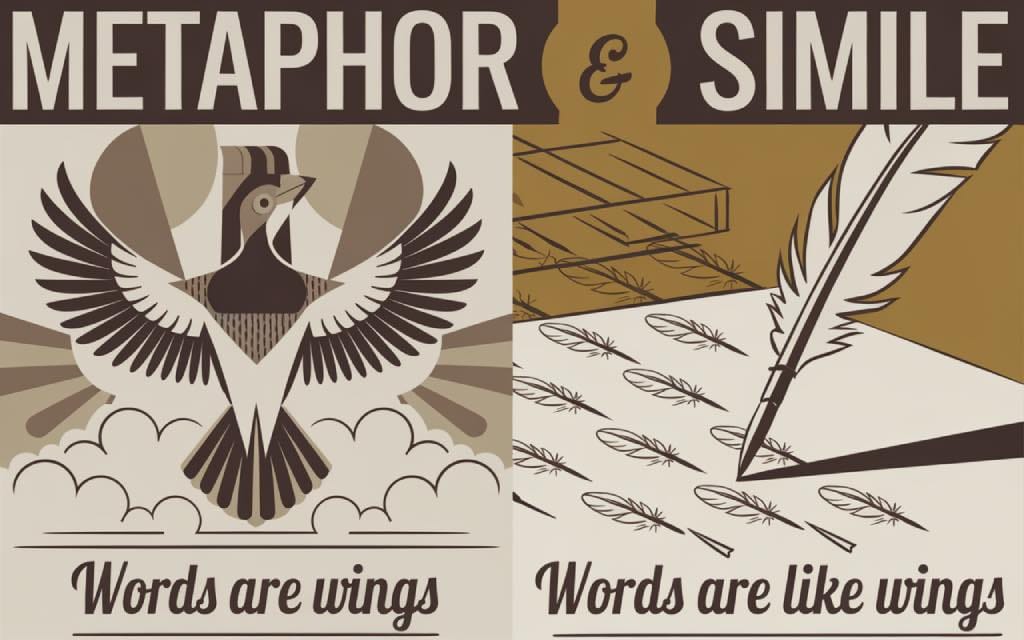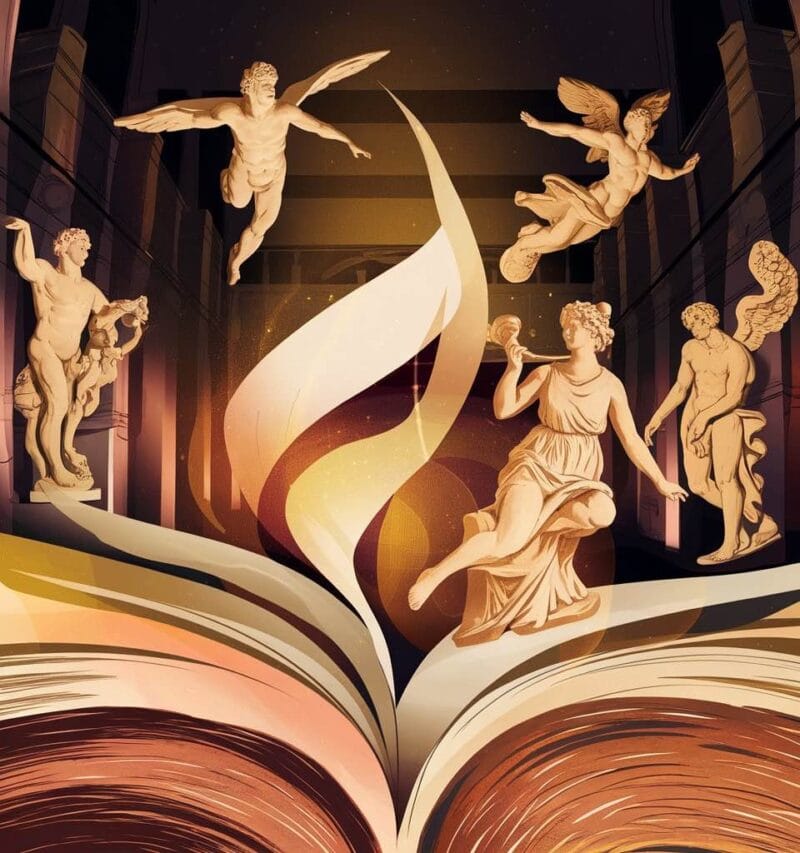Understanding the distinction between metaphors and similes enriches our interaction with language. These literary devices are essential tools that shape expression and add texture to both written and spoken communication.
This article aims to clarify their roles and highlight their impact, showing how these devices enhance communication, amplify the expressive potential of language, and create a greater appreciation for its artistry and power.
What are metaphors and similes?
Metaphors and similes are foundational to expressive language, appearing across genres—from poetry and prose to everyday conversation. Both create connections between seemingly unrelated ideas, sparking deeper meaning and vivid imagery. However, their differing methods shape how they are used and understood.
Defining Metaphors
A metaphor draws a direct comparison between two disparate concepts, merging them to convey a new idea. For instance, the phrase “time is a thief” portrays time as something that steals moments, blending its abstract nature with the concrete traits of theft. This figure of speech often bypasses explicit comparison to embed itself seamlessly in language.
Metaphors have the power to reshape perception, offering fresh perspectives on familiar ideas. They illuminate writing by creating resonant imagery that transcends literal explanation. For example, Emily Dickinson’s “Hope is the thing with feathers” (1862) reimagines hope as a bird, capturing its fragile persistence.
Types of metaphors include:
- Dead metaphors, such as “the foot of the mountain,” which have lost their original vividness through overuse.
- Living metaphors, like “the curtain of night,” which retain their evocative force.
- Extended metaphors, exemplified by William Shakespeare’s “All the world’s a stage” from As You Like It (1623), which unfolds over several lines to draw parallels between life and theatrical performance.
Defining Similes
Similes use “like” or “as” to establish comparisons, creating imagery that is often more direct and accessible than metaphors. For instance, the phrase “as brave as a lion” equates courage to the strength of a lion through explicit comparison. This clarity makes similes versatile, appearing in both formal writing and casual dialogue.
Similes excel at simplifying complex ideas, making them relatable. In The Grapes of Wrath (1939), John Steinbeck describes sow bugs as “like tiny armadillos,” bridging the unfamiliar appearance of the insects with a recognizable image. This device enhances description without requiring elaborate interpretation.
Key Differences Between Metaphor and Simile
The primary distinction lies in their approach to comparison. Similes rely on explicit markers—“like” or “as”—to draw connections, while metaphors embed comparisons more implicitly. For instance:- Simile: “Her smile is as bright as the sun.”
- Metaphor: “Her smile was sunshine.”
Similes often convey meaning swiftly, ideal for situations demanding clarity. Metaphors, however, invite richer associations, lending themselves to layered interpretations. This difference determines their respective strengths in conversation, prose, or poetry.
Figurative Language in Writing
Figurative language, including metaphors and similes, enriches writing by infusing it with imagery and meaning. These devices translate abstract ideas into tangible expressions, making them indispensable for literary and rhetorical purposes.
Consider Franz Kafka’s The Metamorphosis (1915), where the protagonist’s transformation into an insect serves as an extended metaphor for alienation. This application of figurative language highlights broader themes while staying anchored in vivid and memorable imagery.
Tips for Using Metaphors and Similes
To use these devices effectively, consider the following:
- Purpose: Ensure the metaphor or simile aligns with the context and enhances the writing’s intent.
- Clarity: Avoid overly obscure or convoluted comparisons that may confuse rather than illuminate.
- Originality: Strive for fresh, specific comparisons that avoid clichés.
- Restraint: Use figurative language sparingly to preserve its impact.
For example, replacing a worn phrase like “cold as ice” with something more inventive, such as “cold as a January wind,” creates a more vivid and engaging image.
Famous Examples of Metaphor and Simile in Literature
Throughout literature, metaphors and similes have been used to convey profound ideas and create unforgettable imagery. These devices often form the foundation of some of the most celebrated works, which offer fresh perspectives on how we perceive and understand the world. Here are a few notable examples:
Examples of Metaphor
- William Shakespeare’s Macbeth (1606)
In Macbeth, Shakespeare uses the metaphor of life as a fleeting performance:
“Life’s but a walking shadow, a poor player that struts and frets his hour upon the stage.”
This metaphor encapsulates the transience and futility of human existence, reducing life to a momentary and inconsequential act. - F. Scott Fitzgerald’s The Great Gatsby (1925)
The green light at the end of Daisy’s dock serves as a metaphor for Gatsby’s unattainable dreams and the elusive nature of the American Dream. The light symbolizes hope, ambition, and the unending quest for what is just beyond reach. - Sylvia Plath’s The Bell Jar (1963)
Plath employs the metaphor of a bell jar to describe the suffocating pressure of depression:
“Wherever I sat—on the deck of a ship or at a street café in Paris or Bangkok—I would be sitting under the same glass bell jar, stewing in my own sour air.”
The metaphor vividly captures the isolating and oppressive nature of mental illness.
Examples of Simile
- Homer’s The Iliad (~8th century BCE)
Homer’s similes, often called epic similes, are among the most famous in literature. For instance, in describing the Achaeans advancing into battle:
“So he commanded and the armies gave a deep resounding roar like waves crashing against a cliff when the South Wind whips it, bearing down, some craggy headland jutting out to sea.”
This simile conveys the relentless and unified force of the warriors, likening them to nature’s unstoppable power. - William Shakespeare’s Romeo and Juliet (1597)
In Romeo and Juliet, Romeo describes Juliet’s beauty:
“It seems she hangs upon the cheek of night like a rich jewel in an Ethiope’s ear.”
This simile compares Juliet to a bright jewel against a dark background, emphasizing her radiant beauty. - Charlotte Perkins Gilman’s “The Yellow Wallpaper” (1892)
In this story, the narrator describes the oppressive wallpaper as being “like a bad dream.”
This simile encapsulates the growing psychological torment experienced by the protagonist, mirroring her descent into madness.
Practical Application
The thoughtful use of metaphors and similes elevates writing from the mundane to the remarkable. These devices enable writers to express ideas with both precision and artistry, whether in fiction, poetry, or essays.
Mastering these techniques requires practice and careful observation of language. Writers can hone their skills by studying how authors employ figurative language, experimenting with their own comparisons, and revising with an eye toward clarity and impact.
Metaphors and similes are more than decorative devices—they are the scaffolding of expressive language. Whether connecting abstract ideas or evoking vivid imagery, they shape the way we think and communicate. Understanding their potential empowers writers to create language that not only communicates but leaves a profound and lasting impact.
Further Reading
Learning about Figurative Language: How to use simile and metaphor like a boss by Rebecca Hazelton, Poetry Foundation
This figure of speech isn’t dead – it’s just resting by Martin Shovel, The Guardian
The Handle on the Door to a New World: Poet Jane Hirshfield on the Magic and Power of Metaphor, Animated by Maria Popova, The Marginalian
Striking Similes by Dan Piepenbring, The Paris Review




